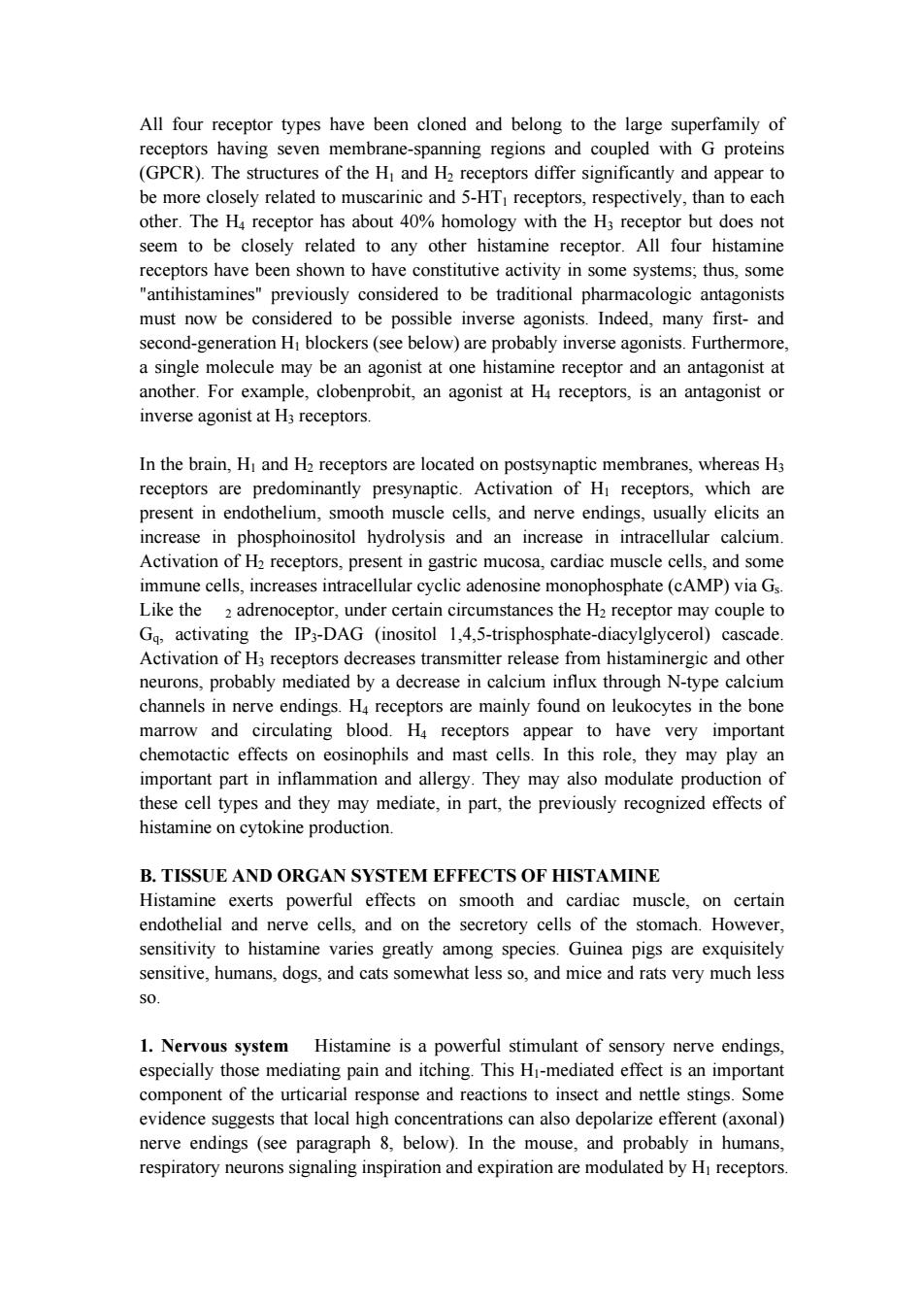正在加载图片...

All four receptor types have been cloned and belong to the large superfamily of receptors having seven membrane-spanning regions and coupled with G proteins (GPCR).The structures of the H and H2 receptors differ significantly and appear to be more closely related to muscarinic and 5-HTI receptors,respectively,than to each other.The H4 receptor has about 40%homology with the H3 receptor but does not seem to be closely related to any other histamine receptor.All four histamine receptors have been shown to have constitutive activity in some systems;thus,some "antihistamines"previously considered to be traditional pharmacologic antagonists must now be considered to be possible inverse agonists.Indeed,many first-and second-generation HI blockers(see below)are probably inverse agonists.Furthermore, a single molecule may be an agonist at one histamine receptor and an antagonist at another.For example,clobenprobit,an agonist at H4 receptors,is an antagonist or inverse agonist at H3 receptors. In the brain,Hi and H2 receptors are located on postsynaptic membranes,whereas H3 receptors are predominantly presynaptic.Activation of Hi receptors,which are present in endothelium,smooth muscle cells,and nerve endings,usually elicits an increase in phosphoinositol hydrolysis and an increase in intracellular calcium. Activation of H2 receptors,present in gastric mucosa,cardiac muscle cells,and some immune cells,increases intracellular cyclic adenosine monophosphate(cAMP)via Gs. Like the 2 adrenoceptor,under certain circumstances the H2 receptor may couple to Gq,activating the IP3-DAG (inositol 1,4,5-trisphosphate-diacylglycerol)cascade. Activation of H3 receptors decreases transmitter release from histaminergic and other neurons,probably mediated by a decrease in calcium influx through N-type calcium channels in nerve endings.H4 receptors are mainly found on leukocytes in the bone marrow and circulating blood.H4 receptors appear to have very important chemotactic effects on eosinophils and mast cells.In this role,they may play an important part in inflammation and allergy.They may also modulate production of these cell types and they may mediate,in part,the previously recognized effects of histamine on cytokine production. B.TISSUE AND ORGAN SYSTEM EFFECTS OF HISTAMINE Histamine exerts powerful effects on smooth and cardiac muscle,on certain endothelial and nerve cells,and on the secretory cells of the stomach.However, sensitivity to histamine varies greatly among species.Guinea pigs are exquisitely sensitive,humans,dogs,and cats somewhat less so,and mice and rats very much less SO 1.Nervous system Histamine is a powerful stimulant of sensory nerve endings, especially those mediating pain and itching.This Hi-mediated effect is an important component of the urticarial response and reactions to insect and nettle stings.Some evidence suggests that local high concentrations can also depolarize efferent(axonal) nerve endings (see paragraph 8,below).In the mouse,and probably in humans, respiratory neurons signaling inspiration and expiration are modulated by Hi receptorsAll four receptor types have been cloned and belong to the large superfamily of receptors having seven membrane-spanning regions and coupled with G proteins (GPCR). The structures of the H1 and H2 receptors differ significantly and appear to be more closely related to muscarinic and 5-HT1 receptors, respectively, than to each other. The H4 receptor has about 40% homology with the H3 receptor but does not seem to be closely related to any other histamine receptor. All four histamine receptors have been shown to have constitutive activity in some systems; thus, some "antihistamines" previously considered to be traditional pharmacologic antagonists must now be considered to be possible inverse agonists. Indeed, many first- and second-generation H1 blockers (see below) are probably inverse agonists. Furthermore, a single molecule may be an agonist at one histamine receptor and an antagonist at another. For example, clobenprobit, an agonist at H4 receptors, is an antagonist or inverse agonist at H3 receptors. In the brain, H1 and H2 receptors are located on postsynaptic membranes, whereas H3 receptors are predominantly presynaptic. Activation of H1 receptors, which are present in endothelium, smooth muscle cells, and nerve endings, usually elicits an increase in phosphoinositol hydrolysis and an increase in intracellular calcium. Activation of H2 receptors, present in gastric mucosa, cardiac muscle cells, and some immune cells, increases intracellular cyclic adenosine monophosphate (cAMP) via Gs. Like the 2 adrenoceptor, under certain circumstances the H2 receptor may couple to Gq, activating the IP3-DAG (inositol 1,4,5-trisphosphate-diacylglycerol) cascade. Activation of H3 receptors decreases transmitter release from histaminergic and other neurons, probably mediated by a decrease in calcium influx through N-type calcium channels in nerve endings. H4 receptors are mainly found on leukocytes in the bone marrow and circulating blood. H4 receptors appear to have very important chemotactic effects on eosinophils and mast cells. In this role, they may play an important part in inflammation and allergy. They may also modulate production of these cell types and they may mediate, in part, the previously recognized effects of histamine on cytokine production. B. TISSUE AND ORGAN SYSTEM EFFECTS OF HISTAMINE Histamine exerts powerful effects on smooth and cardiac muscle, on certain endothelial and nerve cells, and on the secretory cells of the stomach. However, sensitivity to histamine varies greatly among species. Guinea pigs are exquisitely sensitive, humans, dogs, and cats somewhat less so, and mice and rats very much less so. 1. Nervous system Histamine is a powerful stimulant of sensory nerve endings, especially those mediating pain and itching. This H1-mediated effect is an important component of the urticarial response and reactions to insect and nettle stings. Some evidence suggests that local high concentrations can also depolarize efferent (axonal) nerve endings (see paragraph 8, below). In the mouse, and probably in humans, respiratory neurons signaling inspiration and expiration are modulated by H1 receptors